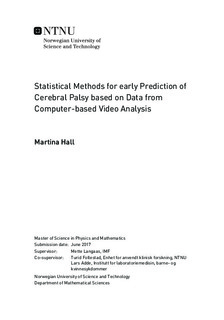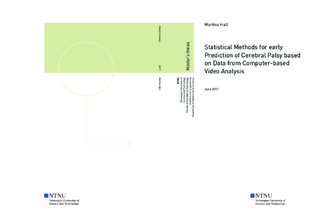| dc.description.abstract | In this thesis we have investigated the association between summary variables from the General Movement Toolbox (GMT), and cases of abnormal fidgety movements (FMs) and cerebral palsy (CP). The GMT-software calculates summary variables from video recordings of infants movements, based on changes of pixel-values between video frames. In previous studies, low values of the variable for variations in the centroid of motion (Csd) have shown to predict both normal FMs and no CP. However, these results were carried out for small datasets, consisting of only Norwegian infants.
Here, we have used data from 693 infants with a total of 798 video recordings from Norway, USA and India. We have use both a frequentist approach with the glmer()- function from the lme4-package and a Bayesian approach with INLA-package, for prediction of FMs in R. Due to repeated measurements, we used a mixed effects logistic regression model with random intercepts, with the Csd variable as covariate. We have also used the same variable in a logistic regression model for prediction of CP. For both models we found the same association as in previous studies, but the effect of Csd on the occurrence of normal FMs varied between countries. To investigate the stability and the uncertainty of the frequentist FM-model for different number of repeated measurements, a simulation study was performed. The results showed that having many observations without repeated measurements could cause unstable results with large confidence intervals for the estimated coefficients. However, for only two or more repeated measurements the estimated coefficient values were much more stable and the size of the confidence intervals were reduced considerably.
In the search for a better model for predictions of CP, we included several GMT-variables and other available variables, and used the Lasso method for variable selection. The results here showed that it was in fact the y-direction of the Csd variable that was associated with the occurrence of CP, but also the mean value in the y-direction of the centroid of motion, mean and standard deviation variables of the area of motion and the standard deviation of the quantity of motion. Inclusion of other available variables increased the model fit a bit. The gender and an indication variable for extreme preterm infants were selected in the model. In addition, the length of the video recordings were accounted for. However, statistical inference, in the form of bootstrapping and the multi sample-splitting method, showed that only the mean value of the centroid of motion in y-direction had a statistically significant association with the occurrence of CP. | |

